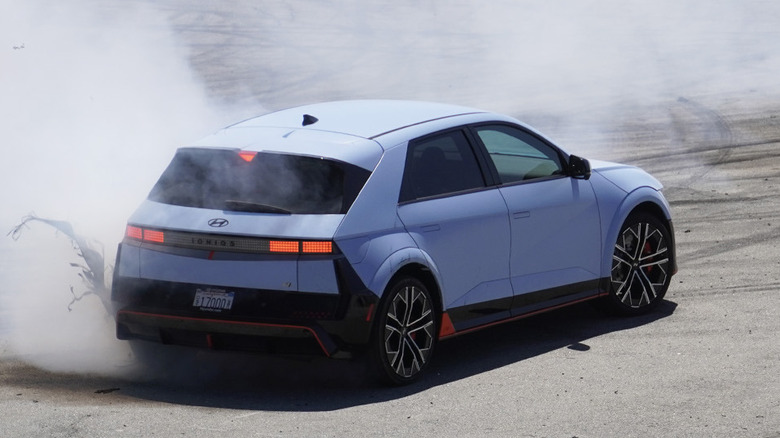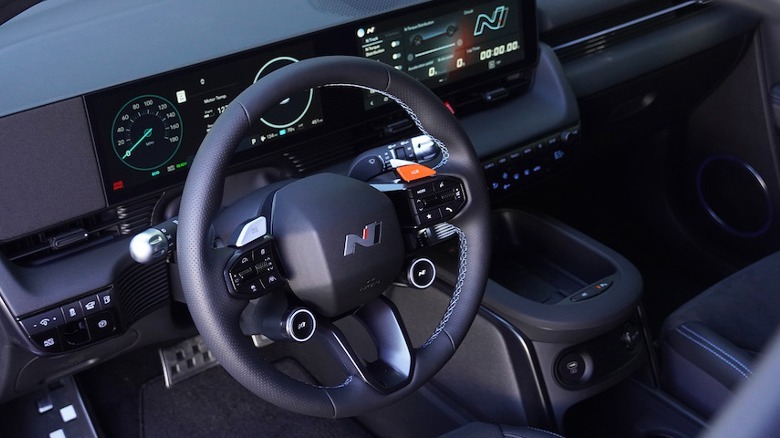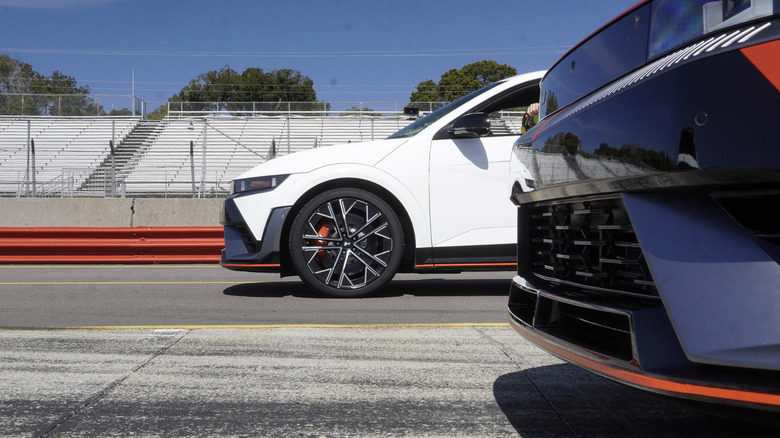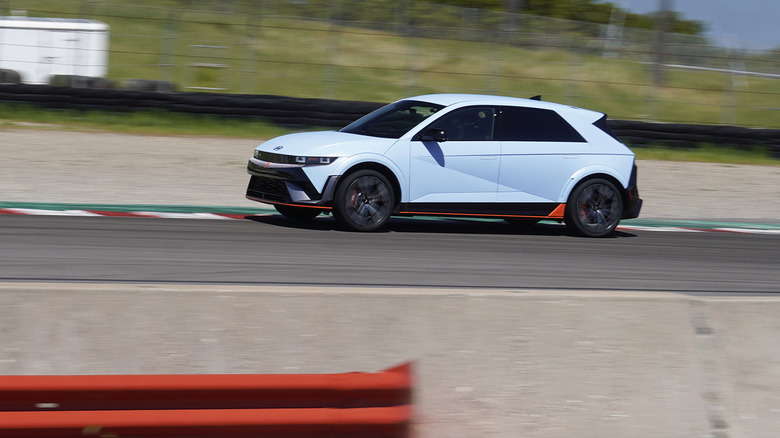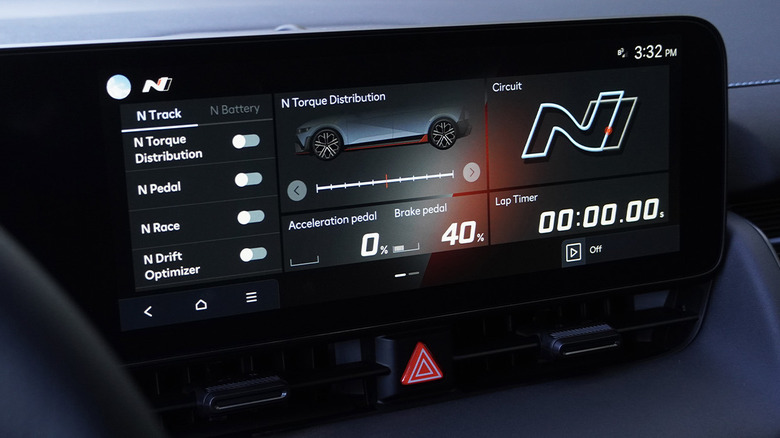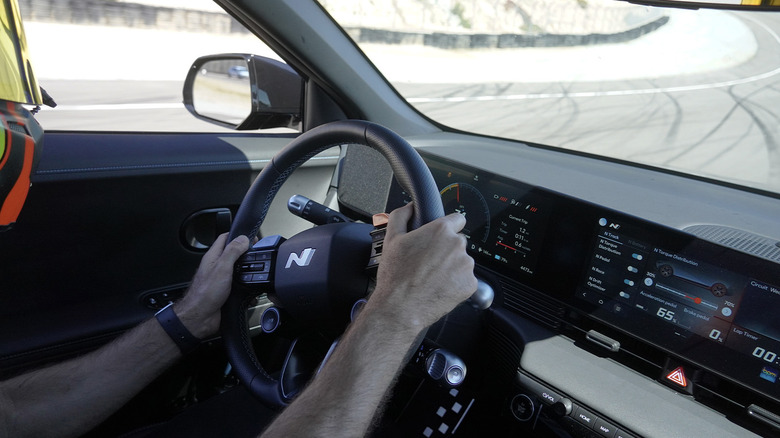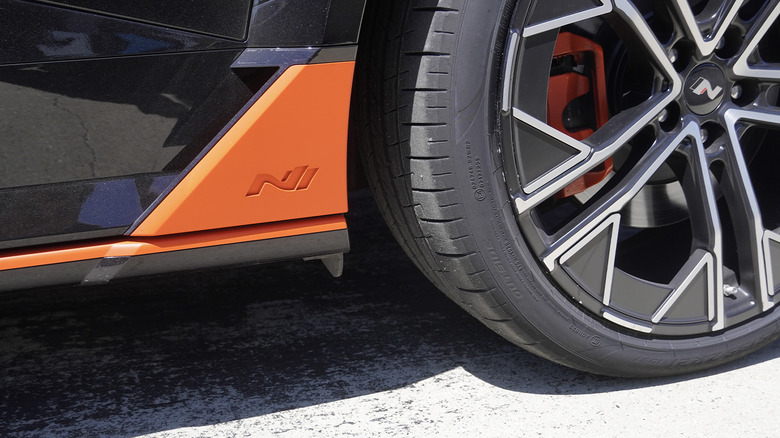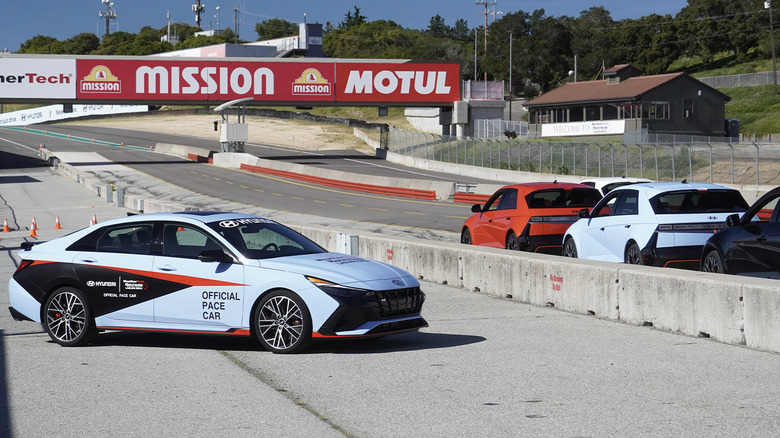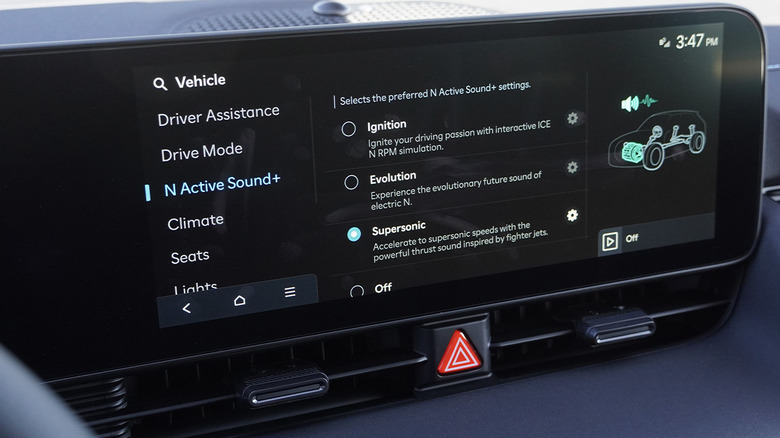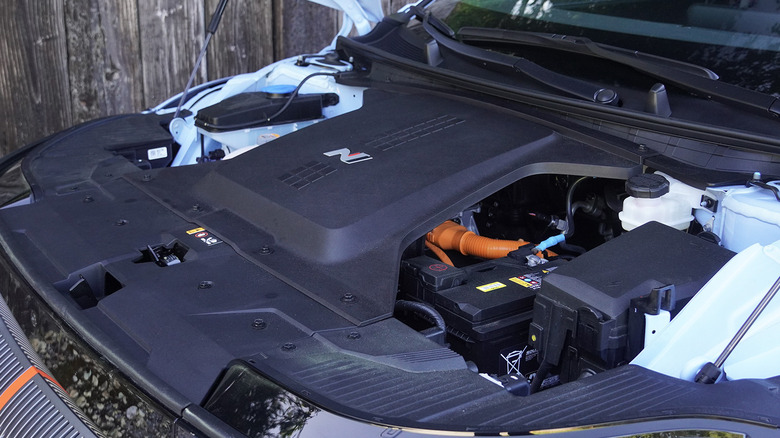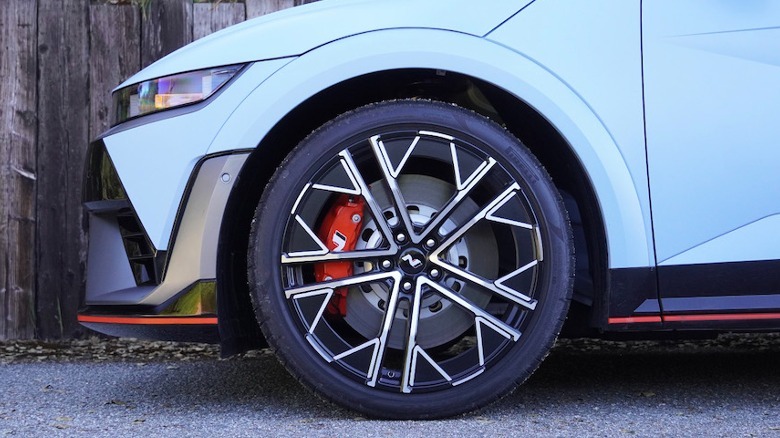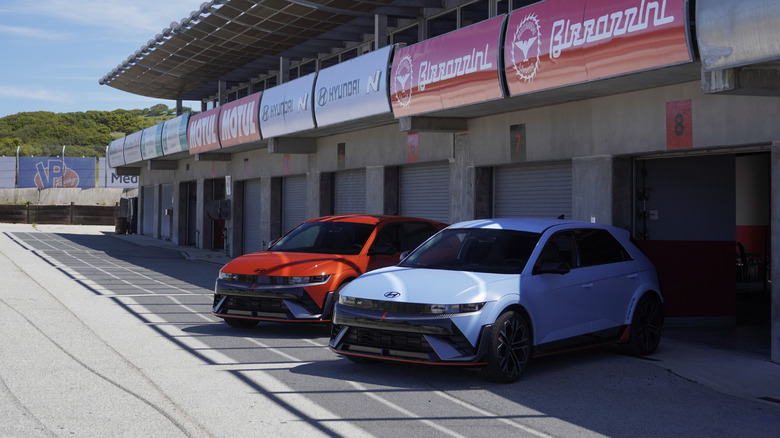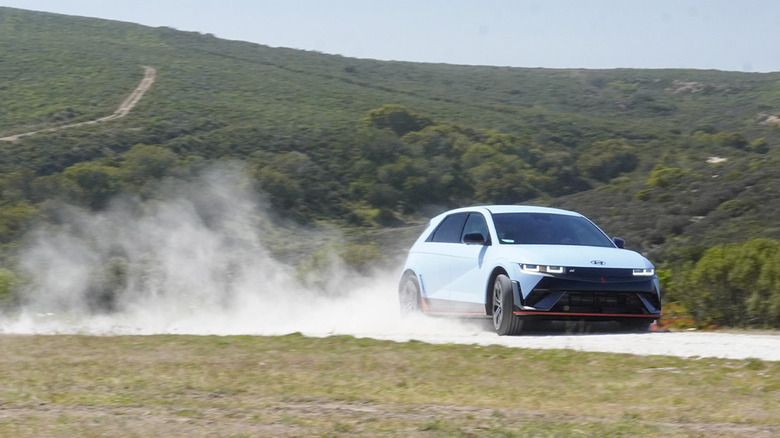2024 Hyundai Ioniq 5 N First Drive: A Wild EV You'll Be Happy Charging More Often
Shoved fully forward into my seatbelt under hard braking, I watch four-time Pikes Peak International Hillclimb winner Robin Shute disappear over the crest of Laguna Seca's infamous Corkscrew. I crank left, find the little broccoli tree that most racers use as a reference point, feel my weight entirely unload before the tires catch, and then almost immediately start to slip again. A bit of countersteer and a hint of intrepid throttle application later, and I hold onto a sliver of hope that I might just maybe stay on Shute's tail through the next wide lefthand sweeper.
Except I can't call it a "throttle," of course, because I'm lapping WeatherTech Raceway Laguna Seca—for my first time ever—in Hyundai's highly anticipated, fully electric Ioniq 5 N. This souped-up version of the Ioniq 5 crossover arrives to the United States for model year 2024 with the dedicated, borderline monumental goal of proving whether or not EVs can actually be fun for enthusiasts.
If a day at, and around, Laguna Seca provides the proof in the proverbial pudding, the answer to that hyperbolic question is, so far, a resounding yes. Maybe even a hell yes, and yet despite the undeniable fun factor, both track time and road driving in the I5 N still raise big questions about actual adoption rates in the real world.
The Ioniq 5 Re-Nvisioned
As expected now from Hyundai's N division, the Ioniq 5 receives a laundry list of revisions to bump it up significantly in spec. In fact, this might represent the most performance-enhanced iteration of any N, when compared to the previous Elantra, Kona, and Veloster packages. Highlights include a massive leap in output, to 601 horsepower and 545 lb-ft of torque out of two motors, and an "N Grin Boost" button that ratchets the insanity further up to 641 hp and 568 lb-ft for a temporary 10 seconds.
To help cope with the additional power, the I5 N chassis also gets 42 new weld points and additional structural adhesives to improve torsional stiffness by a claimed 11%, plus a set of 21-inch wheels shod in new Pirelli P Zero Elect tires measuring 275 millimeters wide at all four corners. Broader wheel arches house those tires, so the whole body swells by over two inches in width and just over three inches in length, the latter thanks largely to additional aero components intended to improve both active cooling of electronic components and a bit of extra downforce at speed. We tested all that out in prototype form late last year, but how does it hold up now these production models are arriving?
Lining up for a lap at Laguna Seca
A larger and denser 84 kWh battery pack feeds the dual electric motors, all of which contributes to a hefty curb weight of 4,861 pounds—a critical stat that flies right out the window once we head out for a first stint on the 2.238-mile circuit. As usual, Hyundai allows drivers to fiddle with just about any setting possible, but in this case, a team of track rats explains how our group of journalistic guinea pigs will proceed through each session while ramping up the various performance modes.
Shute asks for a thumbs up from our train of five Ioniqs, then pulls away for an out lap that I'd classify as somewhere between a warmup and what I might have previously considered fairly serious pace. Staying close, noting his line and braking points while acclimating to a new car and a new track simultaneously, I begin to suspect the pressure will ramp up as soon as we pass the long stop-start straight again.
Sure enough, coming around Turn 11, Shute finally decides to punch the go pedal and launches down the straight. We're in the N's basic Endurance mode, intended for extended lapping, but even as I round that final corner, tires fully squealing, my right foot dips further into the go pedal and the dual motors hook up all four wheels with a sharp jerk, slamming me back into the comfortable and, thankfully, N-bolstered driver's seat.
Early learning in the Ioniq 5 N
By the time we fly over Turn 1—in reality a no-lift blind bend that gets all four wheels airborne once, and sometimes twice—I need to start thinking about braking for another wide left around Turn 2, which some drivers manage by double apexing. My left foot punches the pedal and we hit ABS chatter almost immediately, nose dipping through the first few radians until I figure the two right tires can probably handle a bit more juice.
Easing into power causes just a hint of tail squiggle but with AWD, I believe the N can take it. At this point, a late single apex looks best. About an inch further into the pedal travel, the Pirellis once again squeal through a slightly longer skid, so I flick the steering wheel to the right and we're back out onto a short straight. Shute, meanwhile, has disappeared around the next corner, so I'm on my own to figure out braking points, wide arcs, more blind hillcrests, and the few tight turns at Laguna Seca while holding my own pace until we pull into the pits again.
Nobody wants fake engine noises and gearshifting
During a short break, I realize that leaving admittedly overstimulated automotive journalists to our own devices on a track as challenging as Laguna Seca only reveals Hyundai's immense confidence in the car itself. Only about half the gathered group raised their hands when asked if they'd ever driven here previously—highly questionable, and another reason I want to hang with Shute's pace (other than my inner competitive demons, obviously).
For the next session, we get to—read: are forced to—learn how to manage a novel faux shifting program that transforms the paddles that Hyundai formerly used for regen settings on the base Ioniq 5 into something approaching actual gearshifters. Speakers inside and out pump an internal-combustion engine and turbo soundtrack, whining up to a redline, upon which the car will braap and jolt forward, imitating an actual ICE car reaching fuel cutoff.
Fake engine noises and paddle shifting, for fun
I pull the right paddle, shift up, and prepare to do so again, the auditory stimulus prompting me even if the car still rides smoothly, without any of the other physical feedback that exploding oxygen and dinosaur guts typically produce. Downshifting, especially, seems counterintuitive—don't we have instantaneously available torque? Eventually, I find the power band between what the analog-style gauge readout calls "5,000" to "8,000" RPMs.
The faux shifting works well, even realistically for the most part, but by only a few turns in I conclude that I want to turn it off. As Elon Musk knew from the get-go, the immediate linear shove of EVs makes for serious fun, and now that Hyundai has paired that kind of stupendous power with a truly communicative chassis, sacrificing the futuristic propulsion seems entirely counterproductive to the task at hand. But I can't quite figure out how to switch the settings while trying my darnedest to keep up with Shute (only much later in the day do I realize that the two identical light-blue N buttons on the steering wheel bring up the two different powertrain modes).
Still faked out, but acclimating
For the final session, I specifically request for the paddle shifting to be turned off, but with the car in Sprint mode, rather than Endurance, even on our out lap, I still keep hitting redline. Oh well, someone forgot to lend a helping hand, and anyway, there's no time like the present to learn a little. On this outing, I finally figure out how much braking the Pirellis can handle before unloading, a delicate balance between pedal force and restraint that reveals even further levels of impressive minutiae in the I5 N's chassis tuning. By feathering for a microsecond before punching the pedal, the tires haul down speed without as much ABS interference, which translates to better stability once I begin to transition to steering input.
As a bonus, I'm now allowed to use the red NGS button, for N Grin Shift, which unlocks the extra power for up to 10 seconds before needing another 10 to recharge. Thumbing the button actually produces a fake sort of lurching sensation, too, achieved not just via increased acceleration but because the sounds and screens inside the I5 N all flicker for a second to suggest that every last electron available will now flow to the e-motors. Doing so on Laguna Seca's longer straights noticeably improves my pace, but I learn later that holding the button for shorter bursts requires shorter recovery periods, so might actually do a better job of reeling Shute in coming out of each corner.
The sound effects can turn off
More importantly, though, in Sprint mode the dead inch or so of the right pedal's travel entirely evaporates. I can now much more incrementally modulate power delivery, and thereby the proper application of oversteer, through corners while exploring the full extent of available grip. Hyundai reps repeatedly refer to the Ioniq 5 N's "corner rascal" identity, but the cringey description is unfortunately quite apt.
Learning a new track is always hard, and learning the limits of a new car can still take a while even at this late date in my automotive lifecycle. But learning to drive Laguna Seca in an EV might be the hardest task I've yet faced—luckily, the Ioniq 5 N makes quick work of the challenge, and by the final few laps I can at least keep Shute in sight, dipping into turns, sliding through just a little sideways, and punching out with only a quick snap required to bring the tires back into line. I even momentarily forget about the frustrating "gearing" and nauseatingly fake audio track.
A Group B EV for the 21st century
When I hop out back in the pits, Shute asks if I'm having fun. Uh, yeah, I think so, if my elevated heartrate indicates anything.
"I think the most impressive thing with this car is the fact that you can take it to and well over the limit and really enjoy it," he says. "I don't think we've seen this at all with any other production EV, and it's also very rare with modern cars with all their control systems now. So to be able to achieve that in an electric car and for it to be this fun, I think is absolutely outstanding."
Simply being able to track an EV consistently, I suggest, for multiple sessions across a massive media launch week, indicates how much effort Hyundai put into the Ioniq's battery programming and cooling system development.
"Normally, you would see a Tesla slowing down after half a lap," Shute replies. "So people trying to have fun in their EVs would really have to drive their cars conservatively to enjoy a whole day. But I think we can see here that everyone has forgotten this car is actually electric, we're getting none of the problems we typically see tracking an electric car. And I know from my Pikes Peak testing that there is so much more capability in this car than any other EV I've seen on the market."
Given that Hyundai reps leave the constantly cars running to cool off and keep swapping at least one car out of the rotation to charge after each stint, I raise my eyebrows. More?
"Imagine Group B meets the 21st century," Shute laughs. "Don't let the electric drivetrain fool you, this thing is an absolute riot."
Real-world driving only enhances the Ioniq 5 N's appeal
I discover later how right he is—and that Laguna Seca actually isn't the right place to show off the Ioniq 5 N's best attributes. Sure, up to 641 horsepower sounds great but on a high-speed track, electric acceleration still peters off above 70 miles an hour or so. When I take the N out onto the public roads of Monterey and Carmel Valley, the real rapscallion emerges especially in Sport mode when this little EV proves quite the handful. Here, I can fully sense the rally car spirit shining through: rambuctious, raucous, rowdy... all the R words, apparently.
This already might just be my favorite EV ever, I realize, something akin to the one-off Polestar 2 Arctic Circle concept merged with the BST 270 edition—just better. I start to daydream of an N that's lifted, not dropped, and shod in knobbies rather than high-performing Pirelli eco tires.
But therein lies the Ioniq 5 N's biggest question mark: Most racing and rallying fanatics either love gasoline engines, already own a Civic Type R, or if they're into EVs, probably drive a Model 3 (presumably slammed on airbags, wrapped in chrome, and bumping sick starship sounds, bro). At a starting price of $66,100 with few available options other than the choice of colors, even in the midst of today's rapidly inflating automotive price tiers, the Ioniq 5 N has climbed straight up into luxury levels. That's only a few grand beneath a Lucid Air Pure RWD, which I just happened to test drive the day before Hyundai took us out to Laguna Seca.
An entirely unique EV well into luxury pricing
Lucid's luxury appeal slots in at an entirely different rung than the I5 N, which quite simply lacks the kind of appointments that such a pricetag typically includes. The interior materials still fall on the economy car end of the spectrum, suggesting that every last penny of development dollars went towards performance—not necessarily the worst thing, and money well spent, I can admit. With a shorter wheelbase, tighter steering, and significantly more power, plus the utility of a rear liftgate, the Hyundai nails everything I love about hot hatches.
But performance also affects range, and though the Lucid feels heavier despite weighing around 350 pounds less, it also almost doubles the Ioniq 5 N's 221 miles of range. For many buyers, that number alone might just be the most serious consideration, even if a 10-80% charge time of only 18 minutes makes regular track romps in the Hyundai reasonably feasible.
For now, the N group has delivered something totally unique on the market. I start to daydream: If and when Rivian ever actually releases the mid-size R3X concept as a series production vehicle, that EV needs to take a serious lesson from the rally-hatch racer dynamic that Hyundai absolutely managed to nail. Then, more range (as always) paired with this kind of stellar engagement might, just maybe, give the EV industry a shot at reeling in the true enthusiast automotive crowd.
